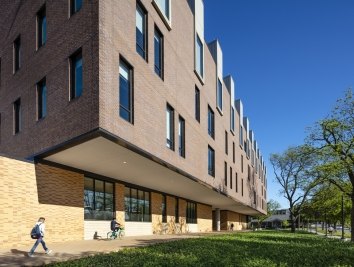A Retrospective: The Evolution of an Arts Center
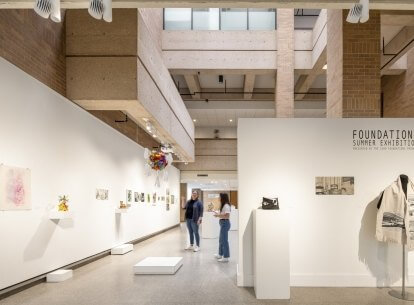
Jeannine Vail, RA, NCARB, LEED AP is an Assistant Professor of Interior Design at the University of North Texas. For 20 years she served as an architect and project manager across multiple disciplines. As the Project Manager for UNT’s College of Visual Arts and Design, Jeannine was instrumental in collaborating with Corgan to design and oversee construction for the arts building restoration and expansion. Five years later, David Zatopek, Senior Project Manager of the Education Studio, sat down with Jeannine to discuss the evolution, changes, and enduring aspects of the art center and how it has enhanced the campus and student experience.

Buildings are designed and constructed by people – if people are involved there will be imperfections — it’s critical to recognize this and to roll with them to build mutual success.
DZ: You have a strong background in both architecture and education. What was the trajectory of your career that landed you as an architect for the University of North Texas?
JV: After building a career as an architect in the private sector for ten years, I transitioned to the university owner side and became a senior project architect for the UNT System, overseeing design from programming-through-construction phases of several campus projects, including the UNT University Union and a 700-seat dining hall. Five years ago. I worked with Corgan on the UNT College of Visual Arts and Design, a project near and dear to my heart. I am also on the faculty, first as an adjunct professor and now as a full-time Assistant Professor and researcher for the Interior Design Department.
DZ: What inspired your passion for teaching and what is your area of focus?
JV: My passion for design in both the academic realm as well as the professional sphere informs my research and teaching. The conviction I impart to my students is that design can bring people with diverse experiences together to generate new and compelling ideas. The focus of my research examines the intersection of multisensory design, interior design education, and practice as it contributes to an equitable learning environment for children with neurodiverse conditions and explores the application of various stimuli – visual, auditory, tactile, and kinesthetic – in conjunction with a classroom environment, to positively contribute to an equitable learning environment for children with learning disabilities, particularly those with dyslexia.
As interior designers, I feel we have a direct influence on creating the physical environment and understanding how a space incorporates the use of multiple senses to potentially enhance and influence people’s interactional behavior. I challenge my students at UNT to ask: what role can Multisensory Design play, as it is applied to the physical setting, to create a more collaborative and caring learning environment?
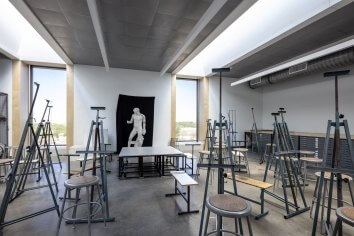
DZ: As the Project Manager over the renovation for the College of Visual Arts and Design, what needs did the building serve and why did the college decide to update the building?
JV: Due to increased enrollment, all art classes were scattered across campus. The department had outgrown the original three-story building -- an outdated brutalist structure built in the 1970s -- which needed to be completely reconfigured to consolidate all the art and design courses under one roof.
DZ: What was the scope of the project?
JV: Unlike the design of say, a science building with similar functions on each floor – an art design college may have 15 unique and diverse programs and each floor must be designed to meet specific needs – painting and drawing, for example, are completely different from ceramics, new media, or printmaking. In some cases, we needed to incorporate technical resources for interactive design, 360 digital capabilities, and acoustics. The design had to be future-forward to meet demands for a changing curriculum – in disciplines that didn’t even yet exist.
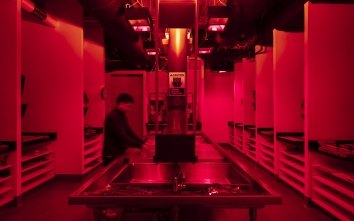
DZ: What were your goals for the planning and vision, and how did Corgan assist you?
JV: We enlisted deans and faculty from each studio to provide leadership for the visioning process. Finding new homes and rearranging classrooms was a huge challenge – and actively working with creative artists with strong opinions about design added a layer of complexity. We also had to find remote studios and supporting spaces to provide education to 2,000 students while renovations were underway.
From the onset, Corgan collaborated with us every step of the way, interacting with various user groups to provide options and point out limitations, while giving us the tools to lead us in the right direction. The design team had the agility to work hand in hand with contractors and consultants to smooth out the bumps and ease problems to keep the project on track.
DZ: What were some of the challenges you encountered along the way?
JV: We had an incredibly tight budget and an insane schedule. Getting the State of Texas to issue funding for an art building is a huge feat, and the university wanted shovels in the ground right away. Plus, in the mid-planning phase, we saw the space simply wasn’t adequate for all the incoming students and needed to shoehorn in a project expansion to add a 15,000-square-foot Foundations Program – with no additional funding or rescheduling. After momentarily panicking, we called Corgan. They went back to the drawing board and assured us we could make this happen – on time and within budget.
DZ: What were some of the design solutions the team came up with to get the project back on track?
JV: The new design was so much better. Adding 130,000 square feet, the design team proposed attaching a backward C-shaped building to the existing structure, creating a dynamic outdoor courtyard for an event destination with a flow-through breezeway to connect to campus. The design provided more amenities and consolidated spaces for functionality and included the following upgrades:
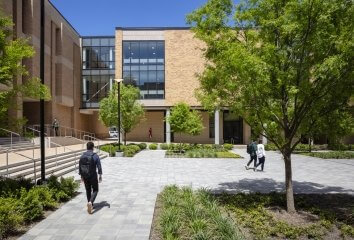
Outdoor trees and seating areas activate events, outdoor learning, and gathering spaces for students along with a stage for graduation ceremonies, outdoor movies, fashion shows, and live music.
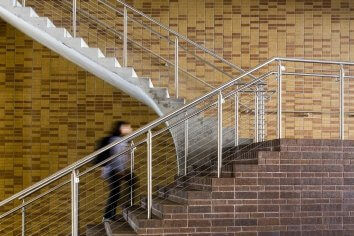
A new stair egress changed the design and created collaborative spaces outside each classroom.
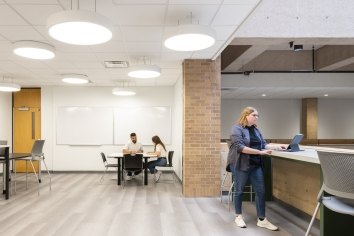
Moving faculty offices to one shared space not only captured square footage but created a flexible and adaptable space to improve interaction between faculty and students.
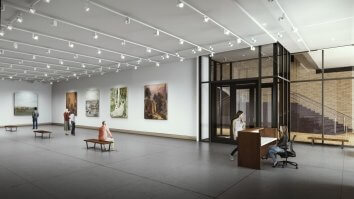
Additional space and a higher ceiling elevation created space for an art gallery to showcase student work.
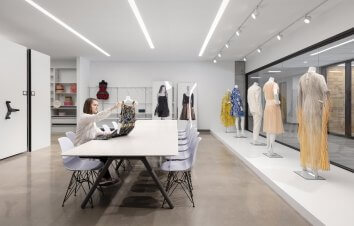
Activated focus areas and views into classrooms creating both safe spots for students to create and explore while also showing projects at work.
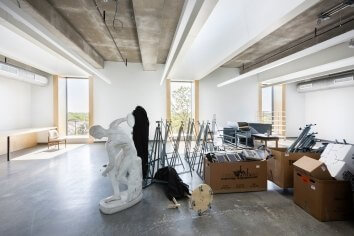
Upgrades to mechanical, electrical, and plumbing, safety and fire codes, and repurposing existing concrete floors, leaving decades-long paint-splatters to recall the artists from past years.
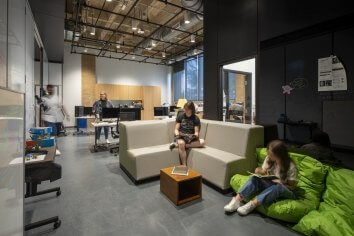
A wing on the third floor houses the foundation's program and provides an inclusive space for lower-classmen to feel included in the program and connected with other students.
The College of Visual Arts and Design is a game changer for the UNT campus. After five years, the arts center has endured as a space to showcase student work, inspire creativity and excitement, build community involvement, and encourage collaborative efforts between students and faculty. The UNT arts program has reaped enormous benefits from the building which has made a huge impact on student learning outcomes, visibility of the arts on campus, and connection to community, contributing not only to the arts college but the entire campus as a whole.





